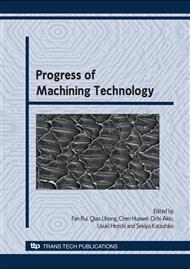p.325
p.329
p.335
p.339
p.343
p.347
p.351
p.355
p.359
High-Efficient Damage-Free Correction of the Thickness Distribution of Quartz Crystal Wafer Using Open-Air Type Plasma CVM
Abstract:
Thickness uniformity of an AT-cut quartz crystal wafer is essential requirement for higher productivity of quartz resonator in the sense of reducing the frequency adjusting process after dicing the wafer. However, commercially available quartz crystal wafers typically have a thickness distribution of ±0.1%, which is induced in conventional mechanical fabrication processes, such as cutting with a wire saw, lapping and polishing. Furthermore, owing to the poor parallelism and the existence of subsurface damage, many spurious peaks, which deteriorate resonance characteristics, are observed in a resonant curve. To resolve these issues, we proposed a new damage-free finishing method to correct the thickness distribution of an AT-cut quartz crystal wafer by the numerically controlled scanning of a localized atmospheric pressure plasma. By applying a new finishing process, the thickness uniformity of a commercially available AT-cut quartz crystal wafer was improved to less than 50 nm level by applying one correcting process without any subsurface damage. Furthermore, applying of the pulse-modulated-plasma drastically decreased the correcting time of the thickness distribution without breaking of the quartz crystal wafer by the thermal stress.
Info:
Periodical:
Pages:
343-346
Citation:
Online since:
February 2009
Authors:
Price:
Сopyright:
© 2009 Trans Tech Publications Ltd. All Rights Reserved
Share:
Citation:


